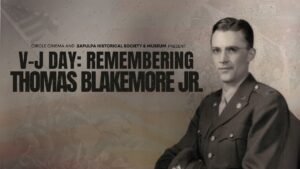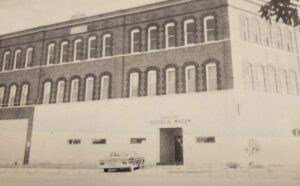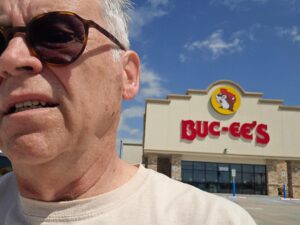Rachel Whitney, Curator,
Sapulpa Historical Museum
The dawn of the new century, the 1900s to 1910s, Hobson Avenue was the gateway for Sapulpa township. Main Street began remodeling their businesses. Dewey Avenue would soon be another place for the “skyscrapers.” What was one of the causes of the new businesses, buildings, and a boom in the population? Oil.
Tulsa claimed itself as the “Oil Capital of the World,” with the first oil strike in 1901. Sapulpa and its surrounding area were not far behind. Sapulpa’s first oil well was in January 1902 at 217 S Poplar. By 1907, it was often said that Oklahoma produced the most oil of any state or territory in the United States.
Sapulpa would have an influx in its population in the first decade of the 20th century; it would have one of the largest growth spurts, percentage-wise, according to population. For instance, in the first decade of the century, Oklahoma City’s population boomed 141% (over 4,000 to 10,000 people); Bartlesville grew 785% (less than 700 to just over 6,000 people); Sapulpa grew over 800% (less than 900 people to over 8,000), whereas, Tulsa grew over 1,000% (with just over 1,000 to 18,000 people) in the span of these ten years*.
*Note: according to the Census records, Sapulpa was among these cities to have the second-highest percentage growth in a decade.
By the end of the decade, Sapulpa gave itself a nickname to meet its rivals. On July 7, 1911, an entrance archway stood over E Hobson Ave, illuminating a greeting to Sapulpa visitors. “‘Sapulpa, the Oil City of the Southwest.’ In letters high above the Hobson Ave crossing of the St. Louis and San Francisco railway tracks, the above electric sign is now emblazoning the story of Sapulpa’s greatness to the night passengers on the greatest railway system traversing the state of Oklahoma.
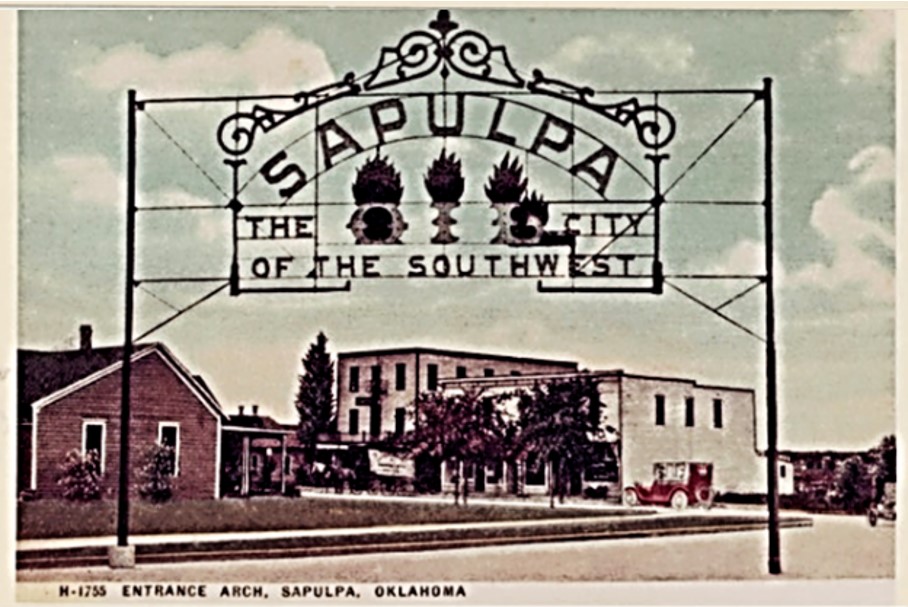
“It contains 700 electric bulbs. The lights surrounding the sign proper flash their rays without intermission, but the big sign is lighted by a flasher, one light following another until all of them are a blaze of glory, followed by the red lights which indicated flowing oil wells, the wells being in the letters ‘O,’ ‘I,’ and ‘L.’’
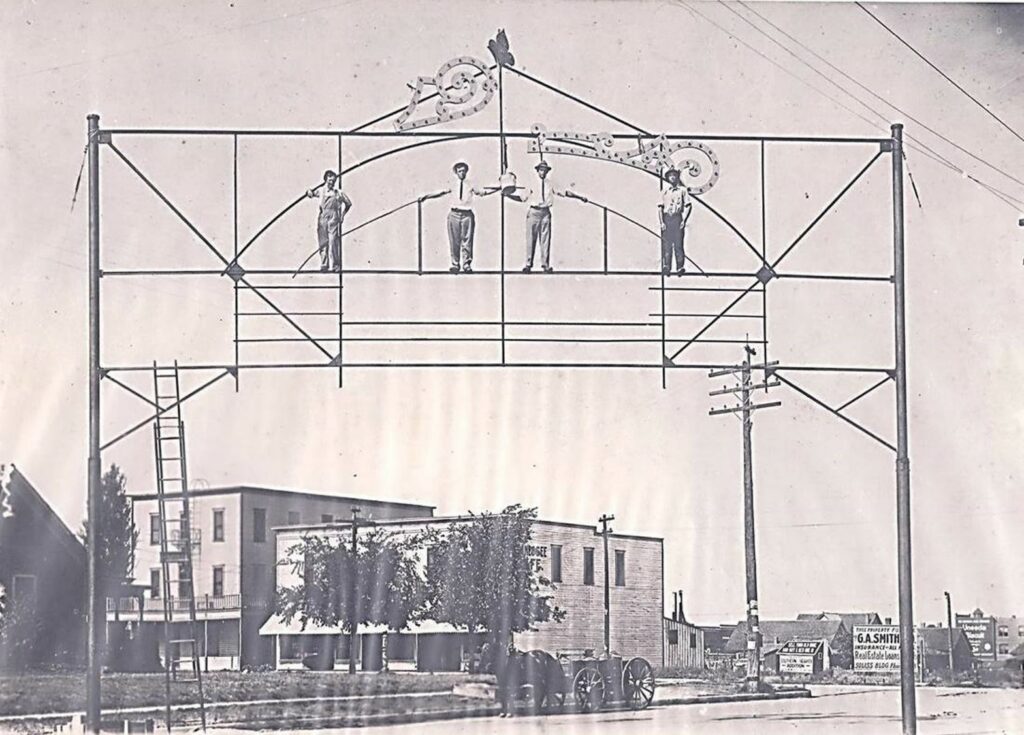
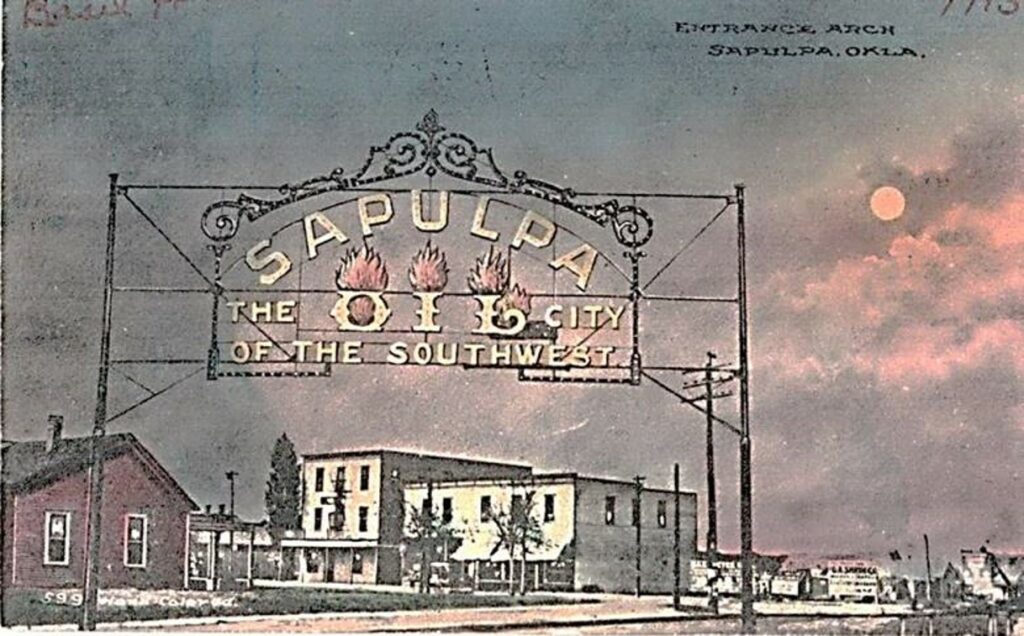

“No other such flash of gladness and advertisement of the products of a great community is to be seen throughout the new state, and the people here are proud of this first flash of the great advertising matter to be seen in announcing the wonders of the metropolis of the oil world. The new sign of welcome can be seen for miles out and the magic city welcomes all of the traveling world to read her story as depicted by the electrical sign that speaks only fact.*”
*Note: The location of Frisco Station was just north of E Hobson and between N Maple to Spruce St. The archway was most likely on E Hobson and N Maple with the lit sign facing east, so that visitors coming from Tulsa would see it coming into town.
The rivalry with Tulsa raged on. By the end of November 1916, Sapulpa and Creek County were showing off their claims as the oil city. “Almost half the oil tax paid to the state comes from Creek Co. – Tulsa Co. is far below us. Tulsa Co. makes strong claims, at home and abroad, of being the oil center of the state. It is interesting to learn from the official figures that almost half the oil tax paid into the state treasury is from Creek Co. in $66,892.03 as against $126,407/23 from the whole state.*”
*Note: Carter Co. was next with $17,772.69 in tax; whereas Tulsa taxed $11,395.68.
In 1917, Sapulpa continued its high. “‘Sapulpa, Oklahoma, known throughout the country as the ‘Oil City of the Southwest’ is located northeasterly part of the state, 281 miles south of Kansas City and 102 miles northeast of Oklahoma City, on the Frisco railroad. It is the county seat of Creek County, one the wealthiest in the entire state. No city is favored with a more healthful and invigorating climate than Sapulpa.”
The illuminated sign continued to flash welcoming visitors to the great oil city. Many people were greeted with warmth radiating from the electrical sign of “Oil City of the Southwest.”
This week in Sapulpa history, the lights went out over E Hobson Ave. On December 18, 1922, the sign will no longer “wink at the public at the Frisco Station. City Commissioners voted to discontinue it. Some of the arguments advanced for so doing were:
“The sign is small town stuff and other cities have stopped using similar slogan signs. The sign often causes merriment instead of wonder. It isn’t worth the $750 a year (roughly $12,700 today) the city must pay for the electricity.
“Some arguments were advanced for keeping the sign. They were that all people passing through on the Frisco, see the sign, and are impressed that Sapulpa is a city of importance. Also, that it gives light there and shows strangers the way to the business section.
“The Commissioners voted 6 to 3 to discontinue the sign.”
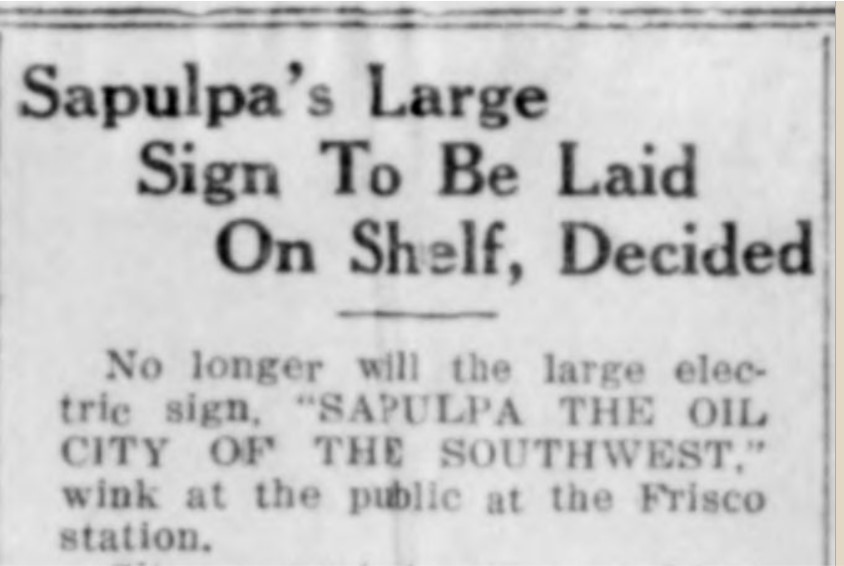
Just six months later, in June 1923, it was decided to tear down the sign. “City Manager recommended that the Commissioners order the big sign taken down at the Frisco Station. The sign is no longer illuminated and the manager stated that parts of the sign have weakened, making it dangerous. A motion was passed authorizing to tear down the sign.”
The original sign was stored away, forgotten. It was rumored that it was scrapped for metal during the Second World War.



